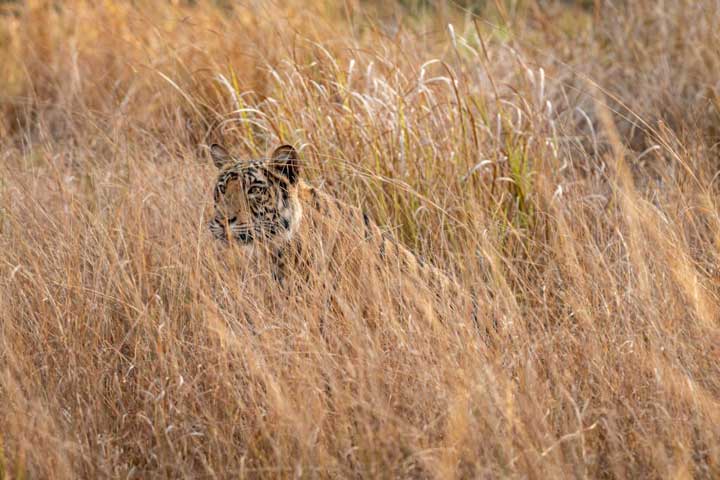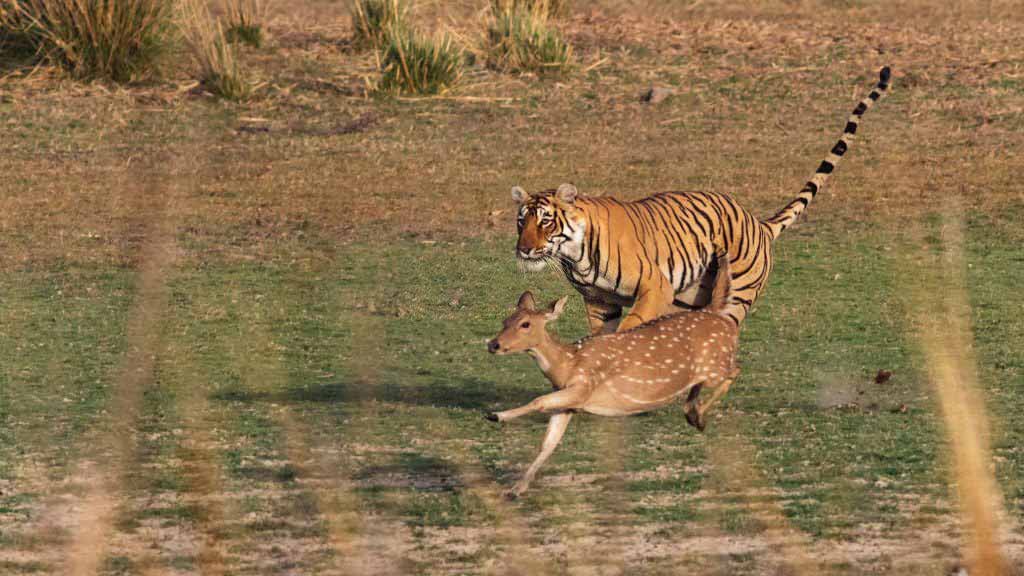The tiger, a symbol of wilderness and raw power, is a magnificent creature and the epitome of hunting mastery. This apex predator’s approach to hunting is a blend of patience, intelligence, and sheer force.
This article delves deep into how tigers hunt, hunting strategy, and challenges.
1. Choosing the Right Prey
Before the chase even begins, the tiger is already making crucial decisions.

- Observing: The tiger keenly observes its territory from a concealed vantage point. It watches potential prey, noting their habits, strengths, and vulnerabilities.
- Strategic Selection: Rather than targeting the largest animal, tigers often opt for those that present the best opportunity for a successful hunt. The young, old, or injured are often chosen due to their vulnerabilities, ensuring a higher likelihood of success.
- Understanding Behavior: Over time, tigers learn to interpret the signals and behaviors of their prey, predicting their next move, which is crucial during the chase.
2. The Hunting Strategy

The hunt’s success often hinges on the tiger’s ability to strategize and wait for the right moment.
- Camouflage: The tiger’s iconic striped fur is nature’s perfect camouflage. It blends seamlessly with tall grasses, dense underbrush, or shadowy forests, making the tiger nearly invisible to its prey.
- Terrain Mastery: Familiarity with their territory gives tigers an edge. They know where to hide, where prey is most abundant, and how to use the wind to their advantage, ensuring their scent doesn’t give them away.
- The Waiting: Tigers can wait for hours, even days, for the perfect moment. This patience often means the difference between success and failure.
3. The Final Charge
When the moment is right, the tiger’s prowess truly shines.

- Silent Stalk: Moving with a stealth that belies its size, the tiger inches closer to its prey, minimizing the distance before the final charge.
- Burst of Speed: The tiger explodes into action when the moment is right. It can reach up to 65 km/h (40 mph) in short bursts, catching its prey off guard.
- Precision in Attack: Tigers don’t just rely on strength. They aim to incapacitate, targeting vital areas like the throat or the back of the neck, ensuring a quick and efficient kill.
Watch: How Do Tigers Hunt?
The Challenges
Even for a master hunter like the tiger, success is not always guaranteed.
- Highly Alert Prey: Prey animals, especially deer, have evolved to detect the slightest threats. Their keen senses can sometimes detect a lurking tiger, challenging the hunt.
- Competition and Threats: The wild is full of competitors. From leopards to wild dogs, many would seize an opportunity to steal a tiger’s kill. There’s also the risk of injury during such confrontations.
- The Success Rate: Despite their unparalleled skills, tigers face a success rate of only 10-20% in their hunts. It’s a testament to life’s challenges in the wild, even for a creature as formidable as the tiger.
Conclusion
The tiger’s hunting technique is a dance of evolution, showcasing nature’s perfect balance of power, strategy, and adaptation.
As we marvel at their prowess, it’s a poignant reminder of the importance of conserving these magnificent creatures, ensuring they continue to reign supreme in their natural habitats.
FAQs
Tigers primarily use the ambush technique. They rely on their striped coat to camouflage with the surroundings, allowing them to get close to their prey without being noticed. Once close enough, they launch a sudden and powerful attack.
Tigers are crepuscular hunters, which means they are most active during dawn and dusk. However, they can hunt at any time of the day or night, depending on the availability of prey.
Tigers have acute senses of hearing and sight, which they use to detect and track their prey. Their whiskers, or vibrissae, also play a role in sensing nearby objects in the dark.
Despite their prowess, tigers have a relatively low success rate, with only about 1 or 2 in 10 hunts resulting in a kill.
Tigers usually kill their prey by delivering a powerful bite to the neck, severing the spinal cord or crushing the windpipe. For larger prey, they might also use their strong forelimbs to bring the animal down.
Humans are not a natural prey for tigers. However, in some rare cases, especially when a tiger is injured or unable to hunt its usual prey, it might turn to hunting humans.



